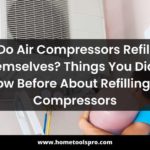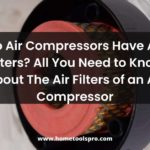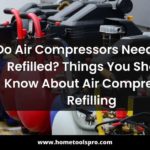As someone who works with air compressors on a regular basis, I know how important it is to understand their power consumption. Knowing how much electricity an air compressor uses can help you make informed decisions about energy efficiency and operating costs.
In this article, we’ll explore the various factors that affect an air compressor’s power consumption and provide tips for reducing your energy usage.
First, it’s important to understand that not all air compressors are created equal when it comes to power consumption. There are several different types of compressors available on the market, each with its own unique set of pros and cons in terms of energy efficiency.
Additionally, factors such as compressor size, motor horsepower, and operating pressure can all impact how much electricity your compressor consumes. By understanding these variables and calculating your operating costs accordingly, you can make smart choices about which type of compressor is best suited for your needs.
Understanding Air Compressor Power Consumption
You’ll be amazed at how understanding the consumption of your air compressor can save you money on energy bills! Air compressors are used in many industries, from construction to manufacturing. They are also commonly used in households for DIY projects and hobbies. However, they consume a considerable amount of electricity, and it’s essential to know how much power they use.
The power consumption of an air compressor depends on various factors, such as its size, type, and usage. The most common measure of power is horsepower (HP), which indicates the motor’s capacity to do work over time. The higher the HP rating, the more electricity an air compressor will use. Additionally, some compressors have variable speed drives that allow them to adjust their energy usage based on demand.
To determine your air compressor’s power consumption accurately, you need to know its wattage or amperage rating. You can find this information on the label attached to the machine or in the owner’s manual. Once you have this information, you can calculate how much energy it uses by multiplying wattage by hours used per day and then dividing by 1,000 (the number of watts in a kilowatt). This calculation will give you an estimate of your daily energy usage.
Understanding air compressor power consumption is crucial because it helps you choose a machine that meets your needs without wasting energy or money. In the next section, we’ll discuss different types of air compressors and their advantages and disadvantages.
Types of Air Compressors
When it comes to air compressors, there are three main types that I find important to discuss: reciprocating, rotary screw, and centrifugal.
Reciprocating compressors use pistons to compress the air and are best suited for smaller applications or intermittent use.
Rotary screw compressors operate by trapping air between two rotating screws and are ideal for continuous operation in larger industrial settings.
Finally, centrifugal compressors utilize high-speed spinning impellers to create kinetic energy that is then converted into pressure, making them perfect for large-scale applications like power plants or oil refineries.
Each type has its own advantages and disadvantages, so understanding the differences can be key in selecting the right compressor for your needs.
Reciprocating Air Compressors
With a reciprocating air compressor, you’ll feel the satisfying rush of pressurized air as it fills up your pneumatic tools. This type of air compressor is also known as a piston or positive displacement compressor. It works by using pistons to compress and then release air into a storage tank. The process repeats until the desired pressure is reached.
Reciprocating air compressors can come in both single-stage and two-stage models. Single-stage models are great for light-duty tasks such as inflating tires or running small tools, while two-stage models are better suited for heavy-duty tasks like sandblasting or painting. These compressors use electricity to operate, so it’s important to know how much power they consume in order to choose the right one for your needs.
Now, let’s take a look at another type of air compressor: rotary screw air compressors.
Rotary Screw Air Compressors
Get ready to experience the impressive force of pressurized air with the state-of-the-art rotary screw compressor. This type of air compressor operates on a completely different principle than reciprocating compressors.
With its two interlocking screws, it works by compressing air internally without producing any pulsation or vibration. As a result, it generates smooth and consistent airflow, making it ideal for continuous use in industrial applications.
One benefit of rotary screw compressors is their higher efficiency compared to reciprocating models. They can deliver more compressed air per unit of energy input, saving you money on your power bills over time. Additionally, they are known for their durability and longevity, as they have fewer moving parts that require maintenance or replacement.
Overall, if you need a reliable source of compressed air for your business operations, the rotary screw compressor may be an excellent investment.
If you’re looking for even more power and speed from your air compressor system, then our next topic about centrifugal air compressors might interest you. These machines can generate high volumes of compressed air at extremely high speeds – perfect for large-scale industrial applications that require rapid processing times.
Centrifugal Air Compressors
You’ll be amazed by the immense speed and volume of compressed air that centrifugal compressors can provide. They are ideal for large-scale industrial applications requiring lightning-fast processing times. These compressors work by using a spinning impeller to increase the velocity of incoming air, which is then slowed down and compressed through a diffuser. The result is high-pressure air that can reach up to 1500 PSIG and flow rates of over 100,000 CFM.
The power required to run a centrifugal compressor varies depending on its size and capacity. Generally speaking, larger compressors require more power than smaller ones due to their higher flow rates. The efficiency of the compressor’s motor also plays a role in determining its power consumption.
As we move onto discussing the energy efficiency of air compressors, it’s important to note that investing in an efficient centrifugal compressor can significantly reduce energy costs in the long run.
Energy Efficiency of Air Compressors
You can make your energy bill sing a sweet tune by investing in an air compressor that’s as efficient as a well-oiled machine. Air compressors are used in all types of industries, and their energy consumption can vary greatly depending on the type of compressor and how it’s used.
One way to measure the efficiency of an air compressor is through its specific power, which is the amount of electricity needed to produce one cubic foot per minute (CFM) of compressed air.
There are several factors that affect the energy efficiency of an air compressor. One is the design and size of the compressor itself. Generally, smaller compressors are more efficient than larger ones because they have less surface area for heat loss and require less energy to start up and run.
Another factor is how often the compressor runs; if it runs continuously, it will consume more energy than if it only runs when needed. To maximize energy efficiency, there are several things you can do.
First, choose an appropriate size for your needs – don’t oversize or undersize your compressor. Second, keep up with regular maintenance such as cleaning filters and checking for leaks. Third, consider investing in newer technologies such as variable frequency drives (VFDs), which adjust motor speed based on demand rather than running at full capacity all the time.
By choosing an efficient air compressor and taking steps to maximize its performance, you can save money on your energy bill while still getting reliable compressed air for your business needs.
In the next section, we’ll look at how to calculate operating costs so you can get a better idea of just how much money you could be saving with an efficient system in place.
Calculating Operating Costs
As I dive deeper into the world of air compressors, I’m curious about the costs associated with operating one. Specifically, I want to know how much it’ll cost me in electricity rates and maintenance fees.
Additionally, I need to consider how many hours per day or week I’ll be using my compressor to get an accurate idea of what this investment will really entail. By taking these factors into account, I can make an informed decision about which air compressor is right for me and my budget.
Electricity Rates
If you’re wondering about the cost of running your air compressor, take a look at your electricity rates to get an idea of how much you’ll be spending. The amount of power used by your air compressor is directly tied to the cost of electricity in your area.
Typically, electric companies charge per kilowatt hour (kWh). This means that for every hour you use your air compressor, you’ll be charged based on the rate they set for each kWh.
It’s important to note that electricity rates can vary depending on where you live and what time of day it is. Some areas have higher rates during peak hours when more people are using electricity, while others may have lower rates during off-peak hours.
Understanding these fluctuations in electricity rates can help you save money on operating costs when using your air compressor. With this knowledge in mind, let’s move on to discussing how many hours per day or week you plan to use your air compressor.
Hours of Use
Now that we know how electricity rates can affect the cost of running an air compressor, let’s talk about the hours of use. The amount of time an air compressor runs is a significant factor in determining its power consumption. The longer it operates, the more energy it uses and the higher your electricity bill will be.
For instance, if you use your air compressor for four hours a day at 10 cents per kilowatt-hour (kWh), you’ll spend approximately $36 a year on electricity costs alone. However, if you increase its usage to eight hours daily, your expenses would double to $72 per year.
Therefore, it is essential to consider how many hours you plan on using your air compressor before purchasing one. This way, you know what to expect when it comes to electricity bills. Speaking of expenses, maintenance and repair costs are also crucial considerations when choosing an air compressor.
Maintenance and Repair Costs
Maintaining and repairing your air compressor can quickly become a costly headache, but with some careful consideration and attention to detail, you can keep your machine running smoothly for years to come.
Regular maintenance includes changing the oil, cleaning or replacing the air filter, checking all the bolts and screws for tightness, draining the moisture from the tank, inspecting hoses and fittings for leaks or damage, and ensuring that all safety features are working correctly. By performing these tasks on a regular basis, you can prevent breakdowns and extend the lifespan of your machine.
However, even with proper maintenance procedures in place, there may be times when repairs are necessary. The cost of repairs will depend on several factors such as the age of your machine, its brand/model/type, complexity of repairs required etc. It’s important to always consult a professional technician if you’re not confident in making repairs yourself.
Properly maintaining your air compressor can help reduce repair costs in the long run while also improving productivity levels. With that being said, let’s move onto some tips for reducing power consumption!
Tips for Reducing Power Consumption
Reducing your air compressor’s energy consumption is easy with these simple tips. First, ensure that your air compressor is properly sized for the job at hand. An oversized compressor can waste a lot of energy, while an undersized one may not be able to handle the workload efficiently. Consult with an expert or use online calculators to determine the correct size for your specific needs.
Secondly, keep your air compressor well-maintained by regularly cleaning or replacing its filters and oil. Dirty filters can restrict airflow, making it harder for the compressor to work efficiently and increasing power consumption. Old oil can also cause friction and heat in the system, requiring more energy to operate.
Lastly, consider using an air receiver tank to store compressed air when demand is low instead of constantly running the compressor at full capacity. This will reduce overall energy consumption and wear on the machine.
By following these tips, you can significantly reduce your air compressor’s power usage and save money on utility bills.
Now that we’ve covered how to decrease energy usage from an existing air compressor, let’s move onto choosing the right one for your needs.
Choosing the Right Air Compressor for Your Needs
As you embark on the search for your perfect air compressor, remember that choosing the right one can be as important as finding the right tool in a toolbox. The first step is to determine what tasks you will need the compressor for and how often you will use it. This will help you determine the appropriate size and power of your air compressor.
When selecting an air compressor, consider its horsepower (HP), cubic feet per minute (CFM) output, and pounds per square inch (PSI) rating. A higher HP rating means more power, but also increases energy consumption. CFM refers to how much air is delivered by the compressor per minute, while PSI indicates how much pressure is generated inside the tank. The type of tools or equipment you plan to use with your air compressor will dictate what HP, CFM, and PSI ratings are required.
Lastly, don’t overlook other factors like portability and noise level when choosing an air compressor. If you plan on moving it around frequently or using it in a smaller workspace, a smaller model may be more suitable. Additionally, if noise levels are a concern for yourself or those around you, look for models designed with quieter operation in mind.
In conclusion, making informed decisions about air compressor power consumption and efficiency requires careful consideration of your specific needs and usage requirements. By selecting an appropriately sized model with efficient power ratings based on your intended applications, you can ensure optimal performance while minimizing energy waste.
Conclusion: Making Informed Decisions About Air Compressor Power Consumption and Efficiency
Now that we’ve established the importance of choosing the right air compressor for your needs, let’s talk about power consumption and efficiency. As someone who’s likely conscious about energy use and cost savings, it’s important to understand how much power an air compressor uses.
The amount of power an air compressor uses depends on several factors such as its horsepower rating, PSI capacity, and duty cycle. A higher horsepower rating generally means more power consumption and a higher PSI capacity requires more energy to maintain pressure. Additionally, if you plan on using your air compressor for extended periods of time, you’ll want to consider its duty cycle which refers to the amount of time it can run continuously without overheating.
Efficiency is also a crucial factor when considering power consumption. Look for air compressors with features such as oil-free pumps or dual piston designs which can improve efficiency and reduce operating costs. It’s also important to regularly maintain your air compressor by cleaning or replacing filters and draining moisture from tanks in order to keep it running at optimal performance levels.
By understanding how much power an air compressor uses and taking steps towards improving its efficiency, you can make informed decisions that not only save you money but also contribute towards building a sustainable future.
Conclusion
In conclusion, understanding air compressor power consumption is essential for making informed decisions about energy efficiency. As I reflect on the types of air compressors and their varying energy efficiencies, I can’t help but think of the analogy of a car’s gas mileage.
Just as a car with poor gas mileage consumes more fuel and costs more to operate in the long run, an inefficient air compressor will consume more electricity and cost more to run over time.
However, by calculating operating costs and implementing tips for reducing power consumption, such as proper maintenance and choosing the right size compressor for your needs, you can save money while still having access to reliable compressed air.
By being knowledgeable about these factors, you can make analytical and detail-oriented decisions that benefit both your wallet and the environment.
So, next time you’re in the market for an air compressor or evaluating your current one’s energy usage, remember that taking steps towards efficiency is not only financially savvy but also environmentally responsible.



